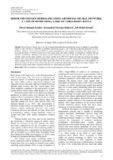| dc.contributor.author | Kanda, Edwin | |
| dc.contributor.author | Kipkorir, Emmanuel | |
| dc.contributor.author | Kosgei, Job | |
| dc.date.accessioned | 2018-06-20T09:56:03Z | |
| dc.date.available | 2018-06-20T09:56:03Z | |
| dc.date.issued | 2016-10-26 | |
| dc.identifier.uri | http://r-library.mmust.ac.ke/123456789/582 | |
| dc.description.abstract | River Nzoia in Kenya, due to its role in transporting industrial and municipal wastes in addition to agricultural runoff to Lake Victoria, is vulnerable to pollution. Dissolved oxygen is one of the most important indicators of water pollution. Artificial neural network (ANN) has gained popularity in water quality forecasting. This study aimed at
assessing the ability of ANN to predict dissolved oxygen using four input variables of temperature, turbidity, pH and electrical conductivity. Multilayer perceptron network architecture was used in this study. The data consisted of 113 monthly values for the input variables and output variable from 2009–2013 which were split into training and testing datasets. The results obtained during training and testing were satisfactory with R2 varying from 0.79 to 0.94 and RMSE values ranging from 0.34 to 0.64 mg/l which imply that ANN can be used as a monitoring tool in the prediction of dissolved oxygen for River Nzoia considering the non-correlational relationship of the input and output variables. The dissolved oxygen values follow seasonal trend with low values during dry periods | en_US |
| dc.language.iso | en | en_US |
| dc.publisher | Journal of Water Security | en_US |
| dc.subject | artificial intelligence technique, feed-forward propagation, pollution monitoring, water quality | en_US |
| dc.title | DISSOLVED OXYGEN MODELLING USING ARTIFICIAL NEURAL NETWORK: A CASE OF RIVER NZOIA, LAKE VICTORIA BASIN, KENYA | en_US |
| dc.type | Article | en_US |

